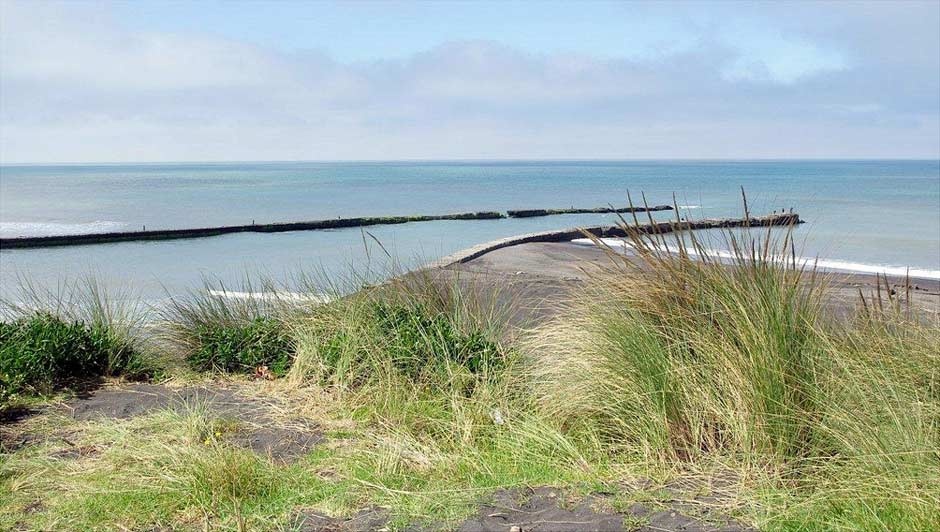
Pātea Port Works (1881-1901)
The big cheese’s graveyard
Unlikely as it may seem, ships from Pātea once provided over half of the port of Wellington’s dairy exports. At first called Carlyle, the little township was a military base during the wars of the 1860s. The shallow, twisting river was a serious impediment to development, however, and the Patea Harbour Board (formed in 1877) had its work cut out. British consultant Sir John Coode recommended the construction of breakwaters out over the entrance and river training walls to concentrate the scour and provide a safe shipping channel to the township. The board completed the eastern breakwater in 1880, but the western one had to wait two decades.
The board lived hand-to-mouth but made gradual if erratic progress. It completed the Town Wharf on the west bank of the river in 1881. Two years later the Railway Wharf opened on the other side of the river. There was work for both, as well as for the Grading Wharf (opened in 1901). The harbour board often struggled to maintain the entrance works, but somehow the little steamers kept threading their way up and down the river, carrying refrigerated produce down to Wellington. They actually loaded a big ‘Home boat’ (as the ships running to the UK were then often called) just off the coast in 1900, but the shipping lines found it easier to subsidise coasters to run down to the capital’s wharves, where their big ships could load in safety. So the port flourished between the wars. In 1921 contractors finished lengthening and raising the breakwaters and a decade later a new freezing works was built and the Grading Wharf was extended. Some days there was even congestion in the port.
Pātea’s end came when the big British lines cut the subsidies. The South Taranaki Shipping Co. ceased trading in 1959. The wharves fell silent and had their decking removed during the 1970s, leaving the piling and the entrance works to mark the port’s passing. In the 1980s the freezing works closed. The cheese factory went, too.
The district council patched up the breakwaters a few years ago and small craft still cross the tricky bar, but these days the little river port is New Zealand’s most poignant industrial graveyard: where else in the country can you find derelict wharves, shipping company offices, freezing works, cheese stores and a railway station within sight of each other?
Further information
This site is item number 58 on the History of New Zealand in 100 Places list.
Websites
- Pātea - Te Ara
- Pātea Māori Club - Roadside Story (video)
- Patea Cheese Boats - New Zealand Ship and Marine Society
Books
- Ian Church, Little ships of Patea, Dunmore Press, Palmerston North, 1977
- Margaret de Jardine, The Little Ports of Taranaki, author, New Plymouth, 1992





Community contributions